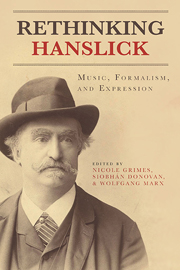Book contents
- Frontmatter
- Contents
- Foreword by Mark Evan Bonds
- Acknowledgments
- Abbreviations
- Chronology
- Introduction
- Part One Rules of Engagement
- Part Two Liberalism and Societal Order
- 5 Hanslick on Johann Strauss Jr.: Genre, Social Class, and Liberalism in Vienna
- 6 Waltzing around the Musically Beautiful: Listening and Dancing in Hanslick's Hierarchy of Musical Perception
- 7 “Poison-Flaming Flowers from the Orient and Nightingales from Bayreuth”: On Hanslick's Reception of the Music of Goldmark
- 8 German Humanism, Liberalism, and Elegy in Hanslick's Writings on Brahms
- Part Three Memoirs and Meaning in Social Contexts
- Part Four Critical Battlefields
- Selected Bibliography
- List of Contributors
- Index
6 - Waltzing around the Musically Beautiful: Listening and Dancing in Hanslick's Hierarchy of Musical Perception
from Part Two - Liberalism and Societal Order
Published online by Cambridge University Press: 05 July 2013
- Frontmatter
- Contents
- Foreword by Mark Evan Bonds
- Acknowledgments
- Abbreviations
- Chronology
- Introduction
- Part One Rules of Engagement
- Part Two Liberalism and Societal Order
- 5 Hanslick on Johann Strauss Jr.: Genre, Social Class, and Liberalism in Vienna
- 6 Waltzing around the Musically Beautiful: Listening and Dancing in Hanslick's Hierarchy of Musical Perception
- 7 “Poison-Flaming Flowers from the Orient and Nightingales from Bayreuth”: On Hanslick's Reception of the Music of Goldmark
- 8 German Humanism, Liberalism, and Elegy in Hanslick's Writings on Brahms
- Part Three Memoirs and Meaning in Social Contexts
- Part Four Critical Battlefields
- Selected Bibliography
- List of Contributors
- Index
Summary
Hanslick's 1854 treatise Vom Musikalisch-Schönen entered the canon of musical aesthetics as an essentially negative formulation of musical beauty, claiming more what beautiful music is not than what it is. Thus, in order to demonstrate what he could not clearly posit in terms of pure sound, Hanslick employed a theory of musical perception as a more substantive criterion of judgment, drawing on various manifestations of listening to describe the effects of musical beauty. This approach led Hanslick to examine the incompetent musical listener as thoroughly as he did the competent listener, the true disciple of the beautiful. As Nicholas Cook puts it, Hanslick's aesthetics was, more than anything else, “a polemic against what he saw as the inadequate manner in which most people listen to music.” Taking his place among a series of critics who discuss the listener's responsibility for musical meaning, Hanslick proposed a hierarchy of listening types that contrasts the intellectual nature of “true listening” with a less admirable, “pathological” type of listening. He refers to the primitive elements of music—sound and motion—as “elemental,” and further brands listeners who are satisfied with a merely sensual relationship to these elements as “enthusiasts.” Their sensitivity is the direct opposite of rational, pure contemplation, “which alone is the true and artistic method of listening.” Offering a model of perception that required educated, attentive listening, Hanslick's treatise contributed to a standard for musical experience that upholds—even to the present—a uniquely suspicious attitude toward human movement.
- Type
- Chapter
- Information
- Rethinking HanslickMusic, Formalism, and Expression, pp. 108 - 131Publisher: Boydell & BrewerPrint publication year: 2013



